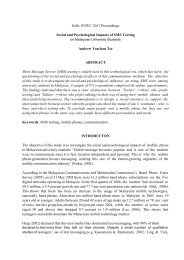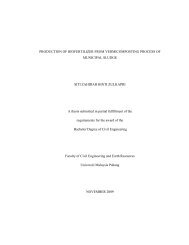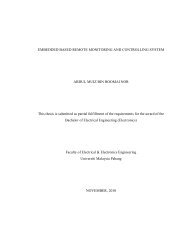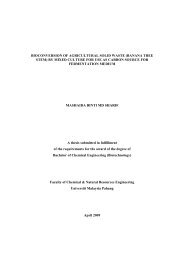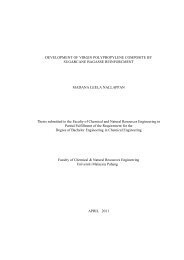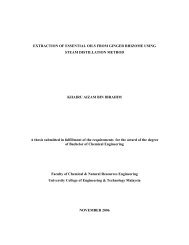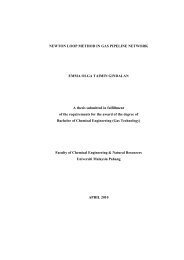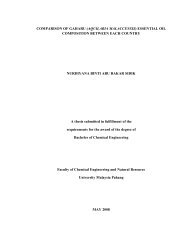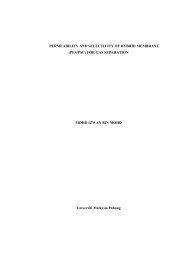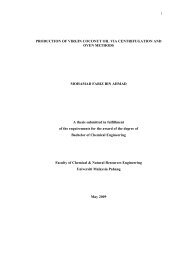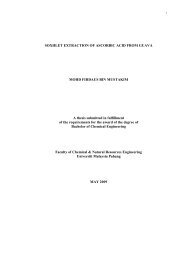Thesis Cik Alin : REMOVAL OF NICKEL FROM AQUEOUS SOLUTION
Thesis Cik Alin : REMOVAL OF NICKEL FROM AQUEOUS SOLUTION
Thesis Cik Alin : REMOVAL OF NICKEL FROM AQUEOUS SOLUTION
Create successful ePaper yourself
Turn your PDF publications into a flip-book with our unique Google optimized e-Paper software.
<strong>REMOVAL</strong> <strong>OF</strong> <strong>NICKEL</strong> <strong>FROM</strong> <strong>AQUEOUS</strong> <strong>SOLUTION</strong> BY USING<br />
DRIED WATER HYACINTH (EICHHORNIA CRASSIPES)<br />
NORHASLIN BINTI HASHIM<br />
A thesis submitted in fulfillment of the<br />
requirements for the award of the degree of<br />
Bachelor of Chemical Engineering<br />
Faculty of Chemical Engineering and Natural Resources<br />
Universiti Malaysia Pahang<br />
MAY 2008<br />
i
I declare that this thesis entitled “Removal Of Nickel From Aqueous Solution By Using<br />
Dried Water Hyacinth (Eichornia Crassipes) “is the result of my own research except as<br />
cited in the references. The thesis has not been accepted for any degree and is not<br />
concurrently submitted in candidature of any other degree.<br />
Signature : …………………………..<br />
Name : NORHASLIN BINTI HASHIM<br />
Date : 14 th MAY 2008<br />
ii
Special dedication to:<br />
For My Mother, Saniah Binti Parni<br />
For My Father, Hashim Bin Bakar<br />
Beloved Siblings: Nasrik, Nazri, Syafina Alia<br />
For My Uncle and Aunty: Pak long, Mak long, Pak Usu, Mak Usu<br />
and<br />
For My lovely Friends<br />
iii
ACKNOWLEDGEMENT<br />
Alhamdulillah. Praise be to God for His help and guidance that I finally able to complete<br />
this thesis. First and foremost I offer my sincerest gratitude to my supervisor Mrs Jun<br />
Haslinda Binti Hj Shariffuddin , who has adviced and guidanced me thoughout my thesis<br />
with her patience and knowledge.<br />
I also thank the members of my graduate committee for their guidance and suggestions,<br />
especially for all his advice, encouragement. I also thank the FKKSA lab staff, without<br />
whose knowledge and assistance this study would not have been successful. The<br />
Chemical Engineering and Natural Resources Faculty has provided the support and<br />
equipment.<br />
To my best friends for their encouragement and support especially at times when things<br />
were going tough. I cannot end without thanking my family, on whose constant<br />
encouragement and love especially my mother, Saniah Binti Parni and my father,<br />
Hashim Bin Bakar. In hope, this study will benefits to all of us.<br />
iv
ABSTRACT<br />
Biosorption has emerged as a new technology compared to classical method like<br />
chemical precipitation for removal metal from aqueous solution. In this present study, a<br />
dried Water Hyacinth (Eichornia Crassipes) was used as a biosorbent for Ni (II) removal<br />
from aqueous solution. The removal characteristics of nickel by dried Water Hyacinth<br />
were evaluated as a function of biosorbent dosage, contact time , pH and temperature .<br />
The percent Ni(II) uptake was analyzed by using Atomic Absorption Spectrophotometer<br />
. At optimal conditions, nickel uptake increased when biosorbent dosage increased. In<br />
this study, the optimum dosage was obtained at 0.3g. Removal of Ni (II) was more than<br />
90% in 50 min of contact time. Removal of Ni (II) using dried Water Hyacinth is highly<br />
pH dependent. Within the tested pH range (pH 2-8), the maximum removal of Ni(II)<br />
was observed between pH 6 . The maximum removal of Nickel is at T= 35 o C. Result<br />
indicates that dried Water Hyacinth is suitable for the removal of nickel from aqueous<br />
solution.<br />
v
ABSTRAK<br />
Proses penyerapan secara biologi muncul sebagai suatu kaedah baru<br />
menggantikan kaedah lama seperti pemendakan kimia untuk menyingkirkan logam dari<br />
larutan akues. Dalam kajian ini, keladi bunting yang di jadikan serbuk digunakan<br />
sebagai agen penyerapan bertujuan untuk menyingkirkan ion Nikel dari larutan akues.<br />
Ciri-ciri keberkesanan keladi bunting sebagai agen penyerapan di uji dengan beberapa<br />
parameter iaitu dos agen penyerapan, masa, pH dan suhu. Peratusan penyingkiran Nikel<br />
dari larutan akues di analisa menggunakan Atomic Absorption Spectrophotometer.<br />
Dalam keadaan optimum, kadar penyerapan nikel berkadar langsung dengan dos agen<br />
penyerapan. Dose maksimum yang dicapai adalah 3g/ L. Penyerapan Nikel melebihi 90<br />
% dalam masa 50 minit ujikaji. Penyerapan Nikel bergantung kepada pH. Julat pH yang<br />
dikaji adalah antara 2 hingga 8. pH maksimum untuk penyerapan Nikel adalah 6 . Suhu<br />
maksimum penyingkiran Nikel dari larutan akues adalah 35 o C. Hasil keputusan dari<br />
parameter yang dikaji menunjukkan keladi bunting amat sesuai dijadikan sebagai agen<br />
penyerapan Nikel.<br />
vi
TABLE <strong>OF</strong> CONTENTS<br />
CHAPTER TITLE PAGE<br />
TITLE i<br />
DECLARATION PAGE ii<br />
DEDICATION iii<br />
ACKNOWLEDGEMENT iv<br />
ABSTRACT v<br />
ABSTRAK vi<br />
TABLE <strong>OF</strong> CONTENTS vii<br />
LIST <strong>OF</strong> SYMBOLS x<br />
LIST <strong>OF</strong> FIGURES xi<br />
LIST <strong>OF</strong> TABLES xii<br />
LIST <strong>OF</strong> APPENDICES xiii<br />
1 INTRODUCTION<br />
1.0 Background of study 1<br />
1.1 Objectives 3<br />
1.2 Scope of study 3<br />
1.3 Problem statement 3<br />
vii
2 LITERATURE REVIEW<br />
2.1 Biosorption 5<br />
2.1.1 Biosorbent 6<br />
2.2 Nickel<br />
2.1.2 Factors that affecting biosorption 9<br />
2.1.3 Biosorption mechanism 10<br />
2.2.1 Characteristics 15<br />
2.2.2 Applications 15<br />
2.2.3 Effects Nickel to environment 16<br />
2.2.4 Effects Nickel to health 16<br />
2.3 Water Hyacinth<br />
2.3.1 Physical description 18<br />
2.3.2 Growth habit 18<br />
2.3.3 Roles of Water Hyacinth in the effluent 19<br />
from waste<br />
3 METHODOLOGY<br />
3.1 Introduction 20<br />
3.2 Overall methodology 21<br />
3.3 Chemical requirements 22<br />
3.4 Chemical equipments 22<br />
3.5 Experimental Methodology 22<br />
viii
3.5.1 Biosorbents preparation 23<br />
3.5.2 Preparation of NiSO4 solution 23<br />
3.5.3 Effect of biosorbents dosage 23<br />
3.5.4 Effect of pH 24<br />
3.5.5 Effect of contact time 24<br />
3.5.6 Effect on temperature 24<br />
3.6 Analysis 25<br />
4 RESULT & DISCUSSION<br />
4.1 Introduction 26<br />
4.2 Effect on biosorbent dosage 26<br />
4.3 Effect on pH value 28<br />
4.4 Effect on contact time 30<br />
4.5 Effect of temperature 31<br />
5 CONCLUSION<br />
5.1 Conclusion 33<br />
5.2 Recommendations 34<br />
6 REFERENCES 36<br />
APPENDIX A 43<br />
APPENDIX B 53<br />
APPENDIX C 58<br />
ix
LIST <strong>OF</strong> SYMBOLS<br />
S - amount of metal absorbed<br />
C - equilibrium solution concentration<br />
K - Freundlich constant<br />
n - Freundlich constant<br />
Ci - initial concentration<br />
Ce - equilibrium concentration<br />
q - adsorbtion capacities<br />
x
LIST <strong>OF</strong> FIGURES<br />
FIGURE NO TITLE PAGE<br />
2.1 Ring structure of carbonate (CO3 2– ) and oxalate 12<br />
(C2O4 2– ) ions.<br />
3.1 Overall methodology 21<br />
4.1 Effect of biosorbent dosage on Nickel removal 28<br />
4.2 Effect of pH on Nickel concentration 30<br />
4.3 Effect of contact time on Nickel removal 31<br />
4.4 Effect of temperature on Nickel removal 34<br />
xi
LIST <strong>OF</strong> TABLES<br />
TABLE NO TITLE PAGE<br />
2.1 A comparison of heavy metal uptake capacities 7<br />
(mg/g) of various macrophytes.<br />
2.2 Unmodified/ modified agricultural waste utilized 8<br />
for remove of heavy metal absorption.<br />
3.1 Characteristics of parameter on Nickel removal 25<br />
4.1 Effect of biosorbent dosage on Nickel removal 27<br />
4.2 Effect of pH on Nickel removal 29<br />
4.3 Table of contact time on Nickel removal 31<br />
4.4 Table of temperature on Nickel removal 32<br />
xii
LIST <strong>OF</strong> APPENDICES<br />
APPENDIX TITLE PAGE<br />
A Results AAs 44<br />
B Analysis of results for experiment 53<br />
C Figures in laboratory experiments 58<br />
xiii
1.1 Background of study<br />
CHAPTER 1<br />
INTRODUCTION<br />
According to the World Health Organization (IARC Monographs on the<br />
Evaluation of Carcinogenic Risks to Humans IARC Monographs Vol 49, 1990 ) , the<br />
carcinogenic risk to humans posed by industrial exposure to nickel and its components<br />
which are metallic nickel and nickel alloys, nickel oxides and hydroxides, nickel sulfides<br />
and nickel salts . Nickel carbonyl is identified as the most acutely toxic nickel<br />
compound, causing severe damage to the respiratory system in experimental animals and<br />
in humans. On the basis of evidence from human and animal studies, welding fumes are<br />
classified as possibly carcinogenic to humans. Nickel are widely use in industrial include<br />
rechargeable (NiCad) batteries, pigments for paints or ceramics, electroplating,<br />
electroforming and sintered metal coatings. These various applications are introduced<br />
into aquatic ecosystems as by-products of industrial processes and acid-mine drainage<br />
residues . The presence of toxic heavy metals contaminated in aqueous streams, arising<br />
from the discharge of untreated metal containing effluent into water bodies, is one of the<br />
most important environmental issues ( Hawari and Mulligan , 2006) . Their presence in<br />
aquatic ecosystem poses human health risks and causes harmful effect to living<br />
organisms (Xuejiang et al., 2006). The effluents from metal finishing processes may<br />
contain up to 10 mg/L of copper, chromium, nickel and zinc. Nickel is a major concern<br />
because the larger usages in developing countries and their no degradability nature.<br />
Therefore, it is important to develop new methods for metal removal and for the<br />
1
eduction of heavy metal ions to very low concentrations. Biosorption, a biological<br />
method of environmental control can be an alternative to conventional physicochemical<br />
technologies waste-treatment facilities such as ion exchange, chemical precipitation,<br />
reverse osmosis and evaporative recovery. This conventional method for this purpose is<br />
often inefficient and/or very expensive ( Chong et al .,Volesky,1995 ; Leusch et al .,<br />
1995;Yu and Kaewsarn , 1999; Zhao et al., 1999) .<br />
Biomaterials that are available in large quantities may have a potential to be used<br />
as low cost adsorbents, because they represent unused resources that are widely available<br />
and environmentally friendly (Deans and Dixon, 1992 ) . Past recent research was still<br />
searching of an effective biosorbent that can be use to remove nickel from aqueous<br />
solution. According to Hanif et al ., 2007 , the percentage sorption Ni(II) ability of C.<br />
fistula (Golden Shower ) from seven industries are in the following order: TILHU (99.88<br />
%) >GI (99.85%) ≈BMI (99.85%) > TIFU (99.80%) > TIHHU (99.78%) > TIDU<br />
(99.77%) Ni–Cr PI (90.59%).However , study on dried Water Hyacinth (Eichornia<br />
Crassipes) as an adsorbent is only few in this field . Hence there is a need to investigate<br />
dry Water Hyacinth ability to remove nickel from aqueous solution.<br />
1.2 Objectives<br />
The goal of this study are :<br />
� To access the ability of Water Hyacinth (Eichhornia crassipes) to remove<br />
Ni(II) from aqueous solution.<br />
� To study the effect of biosorbent dosage, contact time , pH and temperature<br />
in removal of Nickel using biosorption process.<br />
2
1.3 Scope of study<br />
The scopes of study of this project are:<br />
• Biosorbent dosage towards the removal of Nickel from aqueous solution.<br />
• pH values effect in removal Nickel from aqueous solution.<br />
• Contact time towards the removal of Nickel from aqueous solution.<br />
• Effect temperature in biosorption of Nickel from aqueous solution<br />
1.4 Problem statement<br />
Activated carbon usually use by chemical industry for wastewater treatment. The<br />
industries have to spend high cost to buy activated carbon. Due to this problem, some<br />
researcher found the other alternative adsorbent which have characteristic almost the<br />
same like activated carbon especially to remove metal from aqueous solution . Aquatic<br />
plants, such as Water Hyacinth (Eichhornia crassipes), pennywort (Hydrocotyle<br />
umbellate), and duckweeds (Lemna spec.) (US EPA, 1988) are known to be effective in<br />
single pond wastewater treatment.<br />
The major characteristics of Water Hyacinth , that make them an attractive<br />
biological support media for bacteria, are their extensive root system and rapid growth<br />
rate. The root system could act as a cheap biosorbent for various materials which are<br />
soluble in water. Water Hyacinth is now being considered as an aquatic pest in most of<br />
the watersheds where it has been introduced. It can cause enormous ecological and<br />
economical damage when it is not controlled since it suppresses aquatic life ( ZBC News<br />
,2007 ) . Besides that, due to the high rate growth, water hyacinth formed as mats float<br />
on the water surface. It can block an irrigation system, interfere fishing, recreation, and<br />
power generation. These mats also prevent sunlight penetration and reduce the aeration<br />
of water, leading to oxygen deficiency, competitively exclude submerged plants, and<br />
reduce biological diversity. Therefore, this study chooses water hyacinth as biosorbent in<br />
3
solving to environmental problem. The aim of this study is to evaluate the effectiveness<br />
of Water Hyacinth as biosorbent in the removal of Nickel from aqueous solution.<br />
4
2.1 Biosorption<br />
CHAPTER 2<br />
LITERATURE REVIEW<br />
Biosorption can be defined as the ability of biological materials to accumulate<br />
heavy metals from wastewater through metabolically mediated or physico-chemical<br />
pathways of uptake (Fourest and Roux , 1992) . In simple word it can be described as the<br />
binding and concentration of heavy metals from aqueous solutions by certain types of<br />
inactive, dead , microbial biomass . There are several applications of biosorption such as<br />
metal plating and metal finishing operations , mining and ore processing operations ,<br />
metal processing ( waste recovery ) , battery and accumulator manufacturing operations ,<br />
thermal power generation (coal-fired plants in particular) , and nuclear power generation.<br />
Biosorption is a new technology for removing metal ions from aqueous solutions for<br />
replacing conventional methods such as reduction or oxidation, ion exchange , filtration ,<br />
electrochemical treatment , membrane technology , evaporation recovery , chemical<br />
precipitation , chemical lime coagulation and solvent extraction . These conventional<br />
ways has many disadvantages like extremely expensive, incomplete metal removal and<br />
generation of toxic compound. Thus, biosorption is a good method compare with others<br />
because it has major advantages include low cost, high efficiency, minimization of<br />
chemical and or biological sludge, no additional nutrient requirement, regeneration of<br />
biosorbent and possibility of metal recovery ( Kratochvil and Volesky , 1998)<br />
5
2.1.1 Biosorbent<br />
Dead and metabolically inactive cells can serve as a basis for the progress to treat<br />
and removing heavy metals, nuclear fuel and radioactive elements. They can be highly<br />
selective, cheap and efficient compare to activated carbon that used in classical methods.<br />
Some types of biosorbents would be broad range, binding and collecting the majority of<br />
heavy metals with no specific activity, while others are specific from certain metals.<br />
Recent biosorption experiments have focused attention on waste materials, which are by-<br />
products or the waste materials from large-scale industrial operations. For example , the<br />
waste mycelia available from fermentation processes , olive mill solid residues<br />
(Pagnanelli et al ., 2002) , activated sludge from sewage treatment plants (Hammaini et<br />
al , 2003) , biosolids (Norton et al , 2003) , aquatic macrophytes (Keskinkan et al , 2003 ;<br />
Norton et al , 2003 ) used dewatered waste activated sludge from a sewage treatment<br />
plant for the biosorption of zinc from aqueous solutions . The adsorption capacity was<br />
determined to be 0.564 mM/g of biosolids. The use of biosolids for zinc adsorption was<br />
favorable compared to the bioadsorption rate of 0.299 mM/g by the seaweed Durvillea<br />
potatorum (Aderhold et al , 1996) . Keskinkan et al. ( 2003 ) studied the adsorption<br />
characteristics of copper , zinc and lead on submerged aquatic plant Myriophyllum<br />
spicatum. The adsorption capacities were 46.69 mg/g for lead, 15.59 mg/g for zinc and<br />
10.37 mg/g for copper. Table 2.1 gives a comparison of heavy metal uptakes of various<br />
macrophytes.<br />
6
Table 2.1 : A comparison of heavy metal uptake capacities (mg/g) of various<br />
macrophytes<br />
M.spicatum<br />
Adsorbent Metal uptake capacities (mg/g)<br />
( Keskinkan et al., 2003)<br />
M.spicatum<br />
( Wang et al., 1996)<br />
P.lucens<br />
(Schneider and Rubio,1999)<br />
S.herzegoi<br />
(Schneider and Rubio,1999)<br />
E.crassipes<br />
(Schneider and Rubio,1999)<br />
Lead Zinc Copper<br />
46.69 15.59 10.37<br />
55.6 13.5 12.9<br />
14.1 32.4 40.8<br />
- 18.1 19.7<br />
- 19.2 23.1<br />
Another inexpensive source of biomass where it is available in copious quantities<br />
is in oceans as seaweeds, representing many different types of marine macro-algae.<br />
However most of the contributions studying the uptake of toxic metals by live marine<br />
and to a lesser extent freshwater algae focused on the toxicological aspects , metal<br />
accumulation , and pollution indicators by live , metabolically active biomass . Focus on<br />
the technological aspects of metal removal by algal biomass has been rare. Table 2.2<br />
below shows some low cost materials for removal metal.<br />
7
Table 2.2: Unmodified/ modified agricultural waste utilized for remove of heavy metal<br />
adsorption<br />
Species Type of absorbent References<br />
Cu(II) Banana peel Annadurai et al.,<br />
Zn, Cu, Ni Streptomyces rimosus (bacteria),<br />
Saccharomyces cerevisiae (yeast),<br />
Penicillium chrysogenum (fungi),<br />
Fucus vesiculosus and Ascophyllum<br />
nodosum (marine algae<br />
(2002)<br />
Bakkaloglu et al.<br />
(1998)<br />
Ni(II) Hazelnut shell Demirbaş et al.<br />
(2002)<br />
Cr(VI) Hazelnut shell Kobya (2004)<br />
Cr(VI) Activated alumina Bishnoi et al. (2003)<br />
Rice husk<br />
Cd(II) Rice husk Ajmal et al. (2003)<br />
Cd(II) Coirpith Kadirvelu et al.<br />
(2001a)<br />
Ni(II) Coirpith Kadirvelu et al.<br />
(2001b)<br />
Ni(II) Almond husk Hasar (2003)<br />
Cr(VI) Almond shell Dakiky et al. (2002)<br />
Cr(VI) Ethylenediamine-modified rice hull Tang et al. (2003)<br />
8
2.1.2 Factors that affecting biosorption<br />
The investigation of the efficiency of the metal uptake by the microbial biomass<br />
is essential for the industrial application of biosorption , as it gives information about the<br />
equilibrium of the process which is necessary for the design of the equipment . The<br />
metal uptake is usually measured by the parameter 'q' which indicates the milligrams of<br />
metal accumulated per gram of biosorbent material and 'qH' is reported as a function of<br />
metal accumulated, sorbent material used and operating conditions. The following<br />
factors affect the biosorption process:<br />
2.1.2.1 pH seems to be the most important parameter in the biosorptive process: it<br />
affects the solution chemistry of the metals, the activity of the functional<br />
groups in the biomass and the competition of metallic ions (Friis and Myers-<br />
Keith, 1986 ;Galun et al .,1987) .<br />
2.1.2.2 Biomass concentration in solution seems to influence the specific uptake: for<br />
lower values of biomass concentrations there is an increase in the specific<br />
uptake (Fourest and Roux, 1992; Gadd et al., 1988). Gadd et al. ( 1988 )<br />
suggested that an increase in biomass concentration leads to interference<br />
between the binding sites. Fourest and Roux, ( 1992 ) invalidated this<br />
hypothesis attributing the responsibility of the specific uptake decrease to<br />
metal concentration shortage in solution . Hence this factor needs to be taken<br />
into consideration in any application of microbial biomass as biosorbent.<br />
2.1.2.3 Biosorption is mainly used to treat wastewater where more than one type of<br />
metal ions would be present; the removal of one metal ion may be influenced<br />
by the presence of other metal ions. For example: Uranium uptake by<br />
biomass of bacteria , fungi and yeasts was not affected by the presence of<br />
manganese , cobalt , copper , cadmium , mercury and lead in solution<br />
(Sakaguchi and Nakajima, 1991). In contrast, the presence of Fe 2+ and Zn 2+<br />
9
was found to influence uranium uptake by Rhizopus arrhizus (Tsezos and<br />
Volesky, 1982) and cobalt uptake by different microorganisms seemed to be<br />
completely inhibited by the presence of uranium, lead , mercury and copper<br />
(Sakaguchi and Nakajima, 1991<br />
2.1.2.4 Temperature seems not to influence the biosorption performances in the<br />
range of 20-35 0 C (Aksu et al., 1992)<br />
2.1.3 Biosorption mechanisme<br />
Adsorption and desorption studies invariably yield information on the<br />
mechanism of metal biosorption: how is the metal bound within the biosorbent. This<br />
knowledge is necessary for understanding of the biosorption process and it serves as a<br />
basis for quantitative stoichiometric considerations which constitute the foundation for<br />
mathematical modeling of the process.<br />
Various metal-binding mechanisms have been postulated to be active in biosorption,<br />
such as :<br />
• Chemisorption by ion exchange , complexation , coordination and/or chelation<br />
• Physical Adsorption<br />
• Precipitation<br />
• Oxidation/Reduction.<br />
For example, more studies show that fungal biomass and seaweed in particular have<br />
indicated a dominant role of ion exchange metal binding. Indeed, the biomass materials<br />
offer numerous molecular groups which are known to offer ion exchange sites: carboxyl,<br />
sulfate, phosphate, amine, could be the main ones.<br />
10
2.1.3.1 Ion Exchange<br />
Ion exchange is a reversible chemical reaction wherein an ion in a solution is<br />
exchanged for a similarly charged ion attached to an immobile solid particle. These solid<br />
ion-exchange particles are either naturally occurring inorganic zeolites or synthetically<br />
produced organic resins. Synthetic organic resins are the predominant type used today<br />
because their characteristics can be tailored to specific applications.<br />
Ion exchange reactions are stoichiometric and reversible, and as such they are<br />
similar to other solution-phase reactions. For example, in the reaction<br />
NiSO4 + Ca(OH)2 → Ni(OH)2 + CaSO4 ( 2.1 )<br />
The nickel ions of the nickel sulfate (NiSO4) are exchanged for the calcium ions of the<br />
calcium hydroxide Ca(OH)2 molecule .<br />
2.1.3.2 Complexation<br />
The metal removal from solution may also take place by complex formation on<br />
the cell surface after the interaction between the metal and the active groups. Aksu et al.,<br />
1992 hypothesized that biosorption of copper by C. vulgaris and Z. ramigera takes place<br />
through both adsorption and formation of coordination bonds between metals and amino<br />
and carboxyl groups of cell wall polysaccharides . Complexation was found to be the<br />
only mechanism responsible for calcium, magnesium, cadmium, zinc, copper and<br />
mercury accumulation by Pseudomonas syringae . Microorganisms may also produce<br />
organic acids (e.g., citric, oxalic, gluonic, numeric , lactic and malic acids), which may<br />
chelate toxic metals resulting in the formation of metallo-organic molecules . These<br />
organic acids help in the solubilisation of metal compounds and their leaching from their<br />
11
surfaces. Metals may be biosorbed or complexed by carboxyl groups found in microbial<br />
polysaccharides and other polymers.<br />
2.1.3.3 Chelation<br />
The word chelation is derived from the Greek word chele, which means claw,<br />
and is defined as the firm binding of a metal ion with an organic molecule (ligand) to<br />
form a ring structure. The resulting ring structure protects the mineral from entering into<br />
unwanted chemical reactions. Figure 2.1 shows examples the carbonate (CO3 2– ) and<br />
oxalate (C2O4 2– ) ions<br />
Figure 2.1 : Ring structure of carbonate (CO3 2– ) and oxalate (C2O4 2– ) ions<br />
2.1.3.4 Precipitation<br />
Precipitation may be either dependent on the cellular metabolism or independent<br />
of it. In the former case, the metal removal from solution is often associated with active<br />
defense system of the microorganisms. They react in the presence of toxic metal<br />
12
producing compounds, which favor the precipitation process. In the case of precipitation<br />
not dependent on the cellular metabolism, it may be a consequence of the chemical<br />
interaction between the metal and the cell surface. The various biosorption mechanisms<br />
mentioned above can take place simultaneously.<br />
2.1.3.5 Coordination (Complex Formation)<br />
A coordination complex is any combination of cations with molecules or anions<br />
containing free pairs of electrons . Bonding may be electrostatic , covalent or a<br />
combination of both ; the metal ion is coordinately bonded to organic molecules .<br />
Example of the formation of a coordination compound is:<br />
Cu 2+ + 4H2O → [Cu(H2O)]4 2+ ( 2.2 )<br />
Cu 2+ + 4Cl – → [CuCl4] 2– (2. 3 )<br />
Where coordinate covalent bonds are formed by donation of a pair of electrons from<br />
H2O and Cl – (Lewis bases) to Cu 2+ (Lewis acid).<br />
In general, biosorption of toxic metals and radionuclide’s is based on non-<br />
enzymatic processes such as adsorption . Adsorption is due to the non-specific binding<br />
of ionic species to polysaccharides and proteins on the cell surface (Figure 2) or outside<br />
the cell 4,19 . Bacterial cell walls and envelopes, and the walls of fungi, yeasts and algae ,<br />
are efficient metal biosorbents that bind charged groups . The cell walls of gram-<br />
positive bacteria bind larger quantities of toxic metals and radionuclide’s than the<br />
envelopes of gram-negative bacteria .<br />
13
Bacterial sorption of some metals can be described by the linearized Freundlich<br />
adsorption equation:<br />
log S = log K + n log C ( 2.4 )<br />
where:<br />
S is the amount of metal absorbed in µmol/g<br />
C is the equilibrium solution concentration in µmol/L<br />
K and n are the Freundlich constants.<br />
Biomass deriving from several industrial fermentations may provide an<br />
economical source of biosorptive materials. Many species have cell walls with high<br />
concentrations of chitin, a polymer of N-acetyl-glucosamine that is an effective<br />
biosorbent .<br />
Biosorption uses biomass raw materials that are either abundant (e.g., seaweeds)<br />
or wastes from other industrial operations (e.g., fermentation wastes) . The metal-sorbing<br />
performance of certain types of biomass can be more or less selective for heavy metals,<br />
depending on the type of biomass, the mixture in the solution, the type of biomass<br />
preparation , and the chemical-physical environment .<br />
It is important to note that the concentration of a specific metal in solution can be<br />
reduced either during the sorption uptake by manipulating the properties of the<br />
biosorbent or upon desorption during the regeneration cycle of the biosorbent. Due to the<br />
complexity of the biomaterials used, it is possible that at least some of these mechanisms<br />
are acting simultaneously to varying degrees, depending on the biosorbent and the<br />
solution environment.<br />
14
2.2 Nickel<br />
2.2.1 Characteristics<br />
Nickel is silvery-white , hard , malleable , and ductile metal . It is produced by<br />
mining and refining sulphide and oxide ores . It is of the iron group and it takes on a<br />
high polish. It is a fairly good conductor of heat and electricity . Most nickel compounds<br />
are blue or green . Nickel dissolves slowly in dilute acids but , like iron , becomes<br />
passive when treated with nitric acid . Finely divided nickel adsorbs hydrogen .<br />
2.2.2 Applications<br />
Nickel is used in many industrial and consumer products. Common uses of nickel<br />
include production of stainless steel and other corrosion-resistant metals containing<br />
nickel. Other products which contain nickel include rechargeable (NiCad) batteries,<br />
coins , welding rods and wires , electronic or computer equipment , and pigments for<br />
paints or ceramics . Nickel is also used in electroplating, electroforming and sintered<br />
metal coatings. The major use of nickel is in the preparation of alloys. Nickel alloys are<br />
characterized by strength, ductility, and resistance to corrosion and heat. In the<br />
laboratory, nickel is frequently used as a catalyst for hydrogenation , most often using<br />
Raney nickel , a finely divided form of the metal.<br />
2.2.3 Effects of Nickel to environment<br />
Nickel is released into the environment a large number of processes such as<br />
electroplating and steel manufacturing. It will than settle to the ground or fall down after<br />
reactions with raindrops. It usually takes a long time for nickel to be removed from air.<br />
Nickel can also end up in surface water when it is a part of wastewater streams . The<br />
15
larger part of all nickel compounds that are released to the environment will adsorb to<br />
sediment or soil particles and become immobile as a result. In acidic ground however,<br />
nickel is bound to become more mobile and it will often rinse out to the groundwater.<br />
High nickel concentrations on sandy soils can clearly damage plants and high nickel<br />
concentrations in surface waters can diminish the growth rates of algae and<br />
microorganisms.<br />
2.2.4 Effect of Nickel to health<br />
Nickel is naturally present in the environment. Human may also be exposed to<br />
nickel in food and water. Some consumer products that may contain nickel include<br />
jewellery, kitchen tools and coins.<br />
Foodstuffs naturally contain small amounts of nickel. Chocolate and fats are known<br />
to contain severely high quantities. Nickel uptake will boost when people eat large<br />
quantities of vegetables from polluted soils. Plants are known to accumulate nickel and<br />
as a result the nickel uptake from vegetables will be eminent. Smokers have a higher<br />
nickel uptake through their lungs. Finally, nickel can be found in detergents.<br />
Humans may be exposed to nickel by breathing air , drinking water , eating food or<br />
smoking cigarettes . Skin contact with nickel-contaminated soil or water may also result<br />
in nickel exposure. In small quantities nickel is essential, but when the uptake is too high<br />
it can be a danger to human health such as:<br />
16
2.2.4.1 Risk to get lung , nose and prostate cancer<br />
2.2.4.2 Sickness and dizziness after exposure to nickel gas<br />
2.2.4.3 Lung embolisme<br />
2.2.4.4 Respiratory failure<br />
2.2.4.5 Birth defects<br />
2.2.4.6 Asthma and chronic bronchitis<br />
2.2.4.7 Skin rashes – allergic to jewellary<br />
2.2.4.8 Heart disorders<br />
Carcinogenicity- Nickel and certain nickel compounds have been listed by the<br />
National Toxicology Program (NTP) as being reasonably anticipated to be carcinogen.<br />
The International Agency for Research on Cancer (IARC) has listed nickel compounds<br />
within group 1 (there is sufficient evidence for carcinogenicity in humans) and nickel<br />
within group 2B (agents which are possibly carcinogenic to humans) . OSHA does not<br />
regulate nickel as a carcinogen. Nickel is on the ACGIH Notice of Intended Changes as<br />
a Category A1, confirmed human carcinogen.<br />
2.3 Water Hyacinth<br />
Water Hyacinth ( Eichornia Crassipes ) is an aquatic plant which floats on lakes<br />
and slow-moving streams of rivers. It is really beautiful but it can be an environmental<br />
nightmare . Water-hyacinth is a wild fern belonging to the Family Pontederiaceae . A<br />
native to South America, it has been naturalized in many tropical and subtropical regions<br />
of the world. It first appeared in Egypt in the 1890s, then it has invaded many water<br />
ways including African rivers and Lake Victoria.<br />
17
2.3.1 Physical descriptions<br />
It grows up to three feet in height. It has thick, waxy, rounded, glossy leaves,<br />
which rise well above the water surface on stalks. The leaves are broadly ovate to<br />
circular, 4 to 8 inches in diameter, with gently incurved sides, often undulate. Leaf veins<br />
are dense, numerous, fine and longitudinal. Water hyacinth leaf stalks are bulbous and<br />
spongy. Water hyacinth grows an erect thick stalk (to 20 inches long) at the top of which<br />
is a single spike of several (8 to 15) showy flowers . The flowers have 6 petals, purplish<br />
blue or lavender to pinkish, the upper petals with yellow, blue-bordered central<br />
splotches. Water hyacinth reproduces vegetative by short runner stems (stolons) that<br />
radiate from the base of the plant to form daughter plants, and also reproduces by seed.<br />
Its roots are purplish black and feathery.<br />
It grows and spreads rapidly since it has a high growth rate and is able to<br />
reproduce vegetative by the outgrowth of buds on the leaf axils and rootstocks giving<br />
ramets. The ramets eventually break off from the parent plant to become new<br />
individuals. Water hyacinth also has a very high capacity uptake nutrients especially<br />
Nitrogen and Phosphorus from water , and stored it in its tissue.<br />
2.3.2 Growth habit<br />
Water hyacinth can form impenetrable mats of floating vegetation. It reproduces<br />
by seeds and by daughter plants which form on rhizomes and produce dense plant beds.<br />
In one study, two plants produced 1,200 daughter plants in four months. Individual<br />
plants break off the mat and can be dispersed by wind and water currents. As many as<br />
5,000 seeds can be produced by a single plant and these seeds are eaten and transported<br />
by waterfowl. Seedlings are common on mud banks exposed by low water levels.<br />
18
2.3.3 Roles of Water Hyacinth in the effluent from waste<br />
Singhal and Rai ( 2003 ) reported , water hyacinth has potential to clean up<br />
various wastewaters due to its fast growth and large biogas production. It means, water<br />
hyacinth can remove heavy metal that contaminates water that usually comes from<br />
industrial. Several studies have shown, inorganic contaminants such as nitrate,<br />
ammonium and soluble phosphorus, heavy metals can be removed efficiently by water<br />
hyacinth through uptake and accumulation (Reddy et al., 1982; Reddy, 1983; Muramoto<br />
and Oki, 1983; Zhu et al ., 1999). Organic pollutants such as phenols (Nora and Jesus,<br />
1997) also can be absorbed, but whether those kinds of organic contaminants removed<br />
through uptake or an enhancement of mineralization due to the microbial concortia<br />
associated with the root surface is rarely studied and reported.<br />
Previous studies have documented the phytoremediation ability of the obnoxious<br />
free-floating freshwater weed water hyacinth (Eichhornia crassipes (Mart.) Solms) for<br />
nutrient-rich wastewaters (Gamage and Yapa, 2001; Jayaweera and Kasturiarachchi,<br />
2004; Sooknah and Wilkie, 2004; Tripathi and Upadhyay, 2003). The ability of water<br />
hyacinth to remove heavy metals is also well documented (Chua, 1998; Cooley and<br />
Martin, 1979; Cordes et al. 2000; Hardy and O’Keeffe, 1985; Kelley et al. 2000;<br />
Klumpp et al . 2002; Lytle et al.1998; Vesk and Allaway, 1997; Vesk et al. 1999; Wang<br />
et al.2002) though other studies have clearly manifested that hyacinths are more efficient<br />
in the phytoremediation of low concentrations of heavy metals (Hardy and Raber, 1985;<br />
Ingole and Bhole, 2003; Kay et al., 1984; Rulangaranga and Mugasha, 2003 ; Soltan and<br />
Rashed, 2003; Zhu et al.,1999 ).<br />
Previous study did not show dried water hyacinth as biosorbent to remove metal<br />
such as Nickel in biosorption process. Thus, the ability of water hyacinth as biosorbent<br />
needs more research.<br />
19
3.1 Introduction<br />
CHAPTER 3<br />
METHODOLOGY<br />
The purpose of this experimental work is to understand and analyzed result<br />
according to access the ability of Water Hyacinth ( Eichhornia crassipe s) to remove<br />
Ni(II) from aqueous solution and to study the effect of biosorbent dosage , contact time ,<br />
pH and temperature in removal of Nickel using biosorption method .<br />
20
3.2 Overall Methodology<br />
The whole experimental flow will be simplified in Figure 3.1 below.<br />
STAGE 1<br />
Study on biosorption process<br />
Preparation biosorbent from fresh plant water hyacinth<br />
Experiment on different parameter ( dosage of biosorbent<br />
,pH value , temperature and contact time)<br />
STAGE 2<br />
Analyzed the result and choose the optimum dosage , pH ,<br />
contact time and temperature.<br />
Calculation of % removal nickel<br />
Study on the result to conclusion and improvement<br />
Figure 3.1: Overall methodology<br />
21
3.3 Chemical Requirements<br />
3.3.1 Nickel Standard Solutions<br />
3.3.2 0.1M Sodium Hydroxide (NaOH)<br />
3.3.3 0.1 M Hydrochloric Acid (HCL)<br />
3.3.4 Deionized Water<br />
3.3.5 Biosorbent (Enchornia Crassipes )<br />
3.4 Chemical Equipments<br />
3.4.1 Z-5000 Polarized Zeeman Atomic Absorption Spectrophotometer<br />
3.4.2 pH meter (HM 30P)<br />
3.4.3 Orbital shaker (PA 250/25. H)<br />
3.4.4 Octagon siever (OCT-DIGITAL 4527-01)<br />
3.4.5 Electric balance Shimadzu (AW220)<br />
3.4.6 Laboratory blender ( WARING COMMERCIAL)<br />
3.4.7 Oven ( Memmert )<br />
3.4.8 100 mL Erlenmeyer Flask<br />
3.4.9 50 ml beaker<br />
3.4.10 Conical flask<br />
3.4.11 Filter paper<br />
3.4.12 Pippete<br />
3.5 Experimental Methodology<br />
Four parameters that have been test in this experiment:<br />
22
i. Effect on biosorbent dosage<br />
ii. Effect on pH value<br />
iii Effect on contact time<br />
iv Effect on temperature<br />
3.5.1 Biosorbents preparation<br />
The Water Hyacinth (Eichornia crassipes) was collected from lake , Pekan in<br />
September 2007.It was used as the study of material in the experiments on biosorption<br />
process of nickel from aqueous solution. The fresh plant was thoroughly washed with<br />
running water and three times with distilled water to remove dirt .The washed water<br />
hyacinth was oven dried at 60 0 C for 72 hour until constant weight , then cut into small<br />
pieces “with homogenous known particle size of
3.5.4 Effect of pH<br />
For effect of pH experiment, concentration 20 mg L −1 of Ni(II) ions, 2.5 g/L of<br />
biosorbent dose in 100 mL metal solution at room temperature ( 25 o C ) with varying pH<br />
from 1.0 to 10 . The sample was shakes using orbital shaker with 175 rpm for 30<br />
minutes.<br />
3.5.5 Effect of contact time<br />
Effect of contact time was studied at optimum pH 6.0; constant metal<br />
concentration 20 mg L −1 , biosorbent dose 2.5 g/L in 100 mL of the solution at 25 o C.<br />
The sample was shakes using orbital shaker with 175 rpm for 30 minutes. Samples were<br />
taken after 10, 20, 30, 40, 50 and 60 minutes.<br />
3.5.6 Effect of temperature<br />
Effect of contact time was studied at optimum pH 6.0; metal concentration 20 mg<br />
L −1 of Nickel solution and biosorbent dose 2.5 g/L in 100 mL . The sample was shakes<br />
using orbital shaker with 175 rpm for 30 minutes .Samples were taken at 25 o C, 35 o C, 45<br />
o C, 55 o C and 65 o C.<br />
24



